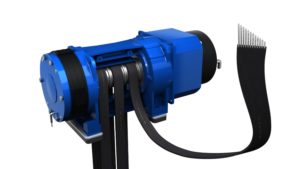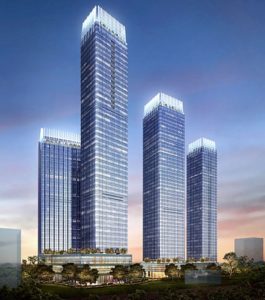
Otis, a global player in the elevator industry, has a longstanding presence in India, having commissioned in first installation way back in 1892. In this exclusive interaction, we have Sebi Joseph, President, Otis India, discussing the company’s journey in India and the way forward. Joseph observes that energy conservation and energy efficiency are becoming important parameters in the elevator industry and Otis, with its Gen2 technology, is fully geared up to tap the booming market in India. An interview by Venugopal Pillai.
In the early part of 2015, Otis India, as we recall, expanded its Bengaluru factory and even installed a very tall test tower. Tell us about the capabilities of the Bengaluru factory and how it is helping Otis improve its market penetration.
Yes, Otis India in early 2015 completed the expansion of its factory in Bengaluru. The facility is now triple in size and has doubled in manufacturing capacity. Co-located with the factory is Otis’ R&D center in India that has also significantly expanded its engineering capacity in recent years. The factory’s new test tower stands at a height of 51.2m and has the ability to test up to five elevators at a time. The test tower also includes mechanical and electrical test labs that are equipped with high-end test equipment staffed by a strong technical team to ensure all new products are tested and qualified to stringent Otis safety, quality and reliability standards.
We gather that the Gen2 technology of Otis has set benchmarks in energy efficiency. Tell us in brief about the technology and the various elevator ranges that are based on this technology.
Otis’ flagship products, the Gen2 range, are geared towards efficiency whilst providing environmentally responsible features and benefits. Some of the key components of the Gen2 range are the coated steel belt, the ReGen™ drive, the permanent magnet machine and the Otis’ PULSE™ system all of which, when combined, increase the life, efficiency, safety and reliability of the elevator. Otis is the pioneer of this technology, which helps achieve substantial energy savings and facilitates environment responsibility.
Otis has sold more than 500,000 Gen2 elevators worldwide since its launch. One of the reasons for this tremendous success is that developers and building owners are becoming environmentally conscious and thereby aim for green certifications like LEED etc. Otis’ Gen2™ Equipment and ReGen™ Drive technology supports these green building initiatives. In fact, a Gen2 elevator with its ReGen drive can reduce energy consumption by 75 percent compared to traditional elevators with conventional drives.
 The Gen2 technology is available in a wide range of speeds and capacities. Gen2 elevators are also available in the compact machine-room configuration and machine-roomless configurations enabling space saving. Particular units available in India are the Gen2 Infinity, with a speed of 1.7 meter-per-second (MPS), the Gen2 Nova, with a speed of 1 MPS and the newest recently launched Gen2 Core, with a speed of 0.7 MPS designed to meet the needs of India’s mass and affordable housing segments. These Gen2 variants are manufactured at the Otis India Bengaluru facility.
The Gen2 technology is available in a wide range of speeds and capacities. Gen2 elevators are also available in the compact machine-room configuration and machine-roomless configurations enabling space saving. Particular units available in India are the Gen2 Infinity, with a speed of 1.7 meter-per-second (MPS), the Gen2 Nova, with a speed of 1 MPS and the newest recently launched Gen2 Core, with a speed of 0.7 MPS designed to meet the needs of India’s mass and affordable housing segments. These Gen2 variants are manufactured at the Otis India Bengaluru facility.
Additionally, Otis has pioneered the Gen2 Switch, which uses less energy than a microwave. The Gen2 Switch plugs into a standard outlet and operates using a battery. If the power goes out, it can make 100 trips in a standard 8-story building.
Give us an idea of the typical energy consumption of elevators in a building, and how energy-efficient elevators can actually bring down energy consumption.
Because of the way elevators use a counterweight, when an empty elevator travels up or a fully loaded elevator travels down, energy is created and often is wasted as heat. The ReGen drive turns this energy into electricity and then feeds this captured power back into the building’s electrical grid for reuse by other building systems such as lighting. The ReGen drive produces “clean power” thanks to low harmonic distortion which minimizes impact on the building’s electrical system and helps protect sensitive equipment. The Otis Gen2 elevator and ReGen drive combine to reduce energy consumption by up to 75 percent under normal operating conditions, compared to conventional systems with non-regenerative drives.
How is Otis, through its energy-efficient technologies, contributing to the Green Building philosophy?
 In the recent past there has been an increased demand for “Green” elevators. As of April 2017, the Indian Green Building Council (IGBC) has 4.5 billion sqft of registered real estate under development as “Green.” This constitutes over 4028 buildings.
In the recent past there has been an increased demand for “Green” elevators. As of April 2017, the Indian Green Building Council (IGBC) has 4.5 billion sqft of registered real estate under development as “Green.” This constitutes over 4028 buildings.
Otis’ flagship products, the Gen2 product family, is geared towards efficiency whilst providing environmentally responsible features and benefits. Some of the key components of the Gen2 range are the coated steel belt, the ReGen™ drive, the permanent magnet machine and the Otis’ PULSE™ system all of which, when combined, increase the life, efficiency, safety and reliability of the elevator. Otis is the pioneer of this technology, which helps achieve substantial energy savings and facilitates environment responsibility.
Otis has sold more than 500,000 Gen2 elevators worldwide since its launch. The reason for this tremendous success is that developers and building owners are becoming environmentally conscious and thereby aim for green certifications like LEED etc. Otis’ Gen2™ Equipment and ReGen™ Drive technology supports these green buildings. In fact, a Gen2 elevator with ReGen regenerative drive can reduce energy consumption by 75 per cent compared to traditional elevators with conventional drives.
We offer several models of the Gen2 elevator. They include the Gen2 Switch, which uses a battery to capture the energy produced by the ReGen drive. If there is a power outage, the elevator can make 100 trips in a seven-story building. Another is the Gen2 Core, which we introduced late last year to meet the needs of the mass and affordable housing segments. The Gen2 Core is manufactured at the Otis India factory in Bengaluru.
How does the expanded and revamped Bengaluru facility align with the “Make in India” endeavour? Do you also intend making this an export hub?
Otis recognizes the opportunity India presents and not too long ago tripled the size of its Bengaluru factory. The expanded facility includes a state-of-the-art elevator test tower that stands at a height of 51.2 meters and has the ability to test up to five elevators at a time. Otis’ R&D center in India has also significantly expanded its engineering capacity in recent years. The Make In India initiative will enable a deeper focus on what the Indian customer and building segment is looking for.
For example, last year Otis introduced the Gen2 Core, an energy efficient elevator designed to meet the needs of the Indian mass and affordable housing segments. With a speed of 0.7 meter-per-second (MPS) and options of machine-room or machine-room less arrangements, this elevator is ideal for low-rise residential buildings. Affordable homes make up almost 90 percent of the demand for homes in India. Prior to this Otis India introduced the Gen2 Infinity. This is a higher speed (1.75 meters per second) passenger elevator that caters to mid-rise residential buildings, which are fast becoming a common feature across tier 1 and 2 cities in the country today. The Otis Bengaluru factory is gearing up to offer even higher speed elevators on Otis’ global flagship technology platform – the Gen2. Otis is committed to the Indian customers, and strives to locally design and manufacture quality products for India’s unique needs.
What would you regard as the principal growth drivers for the Indian elevator industry?
340 million people, or 30 percent of the country’s population, currently live in cities. According to a recent McKinsey report, by 2030 it is expected that cities will house 590 million people or 40 percent of the population, and that India will have 68 cities with populations of more than 1 million. Future cities and developing economies hold a lot of potential for infrastructure growth and therefore, urbanization is a major driver for the elevator segment in India.
Apart from elevators, Otis has been a prominent supplier of escalators. Tell us about the escalator market in India and the current share of Otis India. How do you rate metro rail as a demand driver for escalators? What are the other demand drivers?
Escalators account for a very small fraction of the India elevator and escalator segment. With the government’s focus on growth of infrastructure to support urbanization, the year on year growth for escalators is expected to be promising. Otis is a prominent manufacturer of escalators and have been suppliers to prestigious projects like Hyderabad Metro and Delhi Metro with 410 and 222 escalators respectively.
As we see, Otis has been India’s oldest supplier of elevators with a standing of over 60 years. Tell us in brief how the journey has been. What would you regard as your most prestigious installations in India?
In fact, Otis has a 125-year legacy in India. In 1892, it installed the first elevator in Kolkata’s Raj Bhavan. The company formally set up operations in India in 1953,which is over 60 years ago. Every customer is important to us. To ensure easy access to each of our customers, Otis has over 80 service centers servicing 300 cities – the largest service network in the country today.


